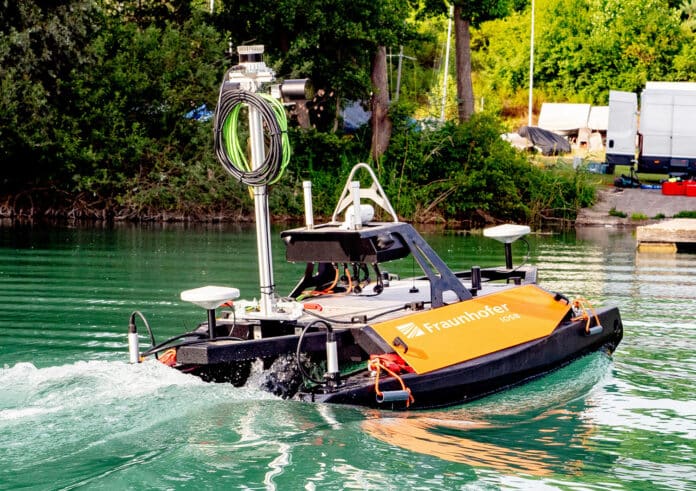Large water body mapping provides important information about the depth of the watercourse, the soil and bank conditions, the bed structure, the longitudinal and transverse profiles, port facilities and bridge structures, the condition of the watercourse, and much more. These maps need to be compiled and updated regularly by the relevant authorities, which is very costly, as the surveys are currently carried out manually with the help of specialists on mapping vessels.
Using autonomous watercraft to carry out underwater and surface mapping could be far less expensive. With this in mind, researchers at the Fraunhofer Institute of Optronics, System Technologies, and Image Exploitation IOSB have developed an easy-to-operate, unmanned watercraft that autonomously surveys bodies of water such as rivers, lakes, and harbors both above and below the surface and produces corresponding 3D maps.
The survey vessel is connected only to a central control station on land and can map depths of up to 100 meters in its current form.
Weighing only 64 kg, the unmanned surface vessel (USV) is 2 m long, 1.5 m wide, and 1 m high. The area to be surveyed is first specified; the software then uses this information to calculate the route. Next, the vessel comes into play.
The unmanned watercraft uses its GPS, acceleration and angular rate sensors, and a Doppler velocity log (DVL) sensor to incrementally feel its way along the bottom of the body of water. In combination with mapping software, laser scanners, and cameras enable the device to reconstruct high-precision 3D models of the surroundings above water. A multi-beam sonar integrated into the sensor system is used for underwater mapping and creating a complete 3D model of the bed.
“Our navigation system is semi-automatic in that the user only needs to specify the area to be mapped. The surveying process itself is fully automatic, and data evaluation is carried out with just a few clicks of the mouse. We developed the software modules required for the mapping and autonomous piloting,” explains Dr. Janko Petereit, a scientist at Fraunhofer IOSB.
During the journey, it autonomously avoids obstacles detected by the laser scanner and sonar and generates a 3D model in real time for navigation purposes, including dynamic objects such as moving vessels.
A second high-precision 3D model is computed by the software after data evaluation, capturing both the floor of the body of water and the scene above the water surface whilst also hiding moving objects.
The operational prototype is currently being used by the Fraunhofer research group “Smart Ocean Technologies” in Rostock in other projects that focus on underwater and surface robotics.
“Currently, manual surveys are only conducted every one or two years and provide far less accurate results than our comprehensive 3D models, so the condition of the waterways is not optimally captured. River surveys will therefore need to be conducted far more often in the future and with a higher level of detail. Our semi-automatic navigation system offers a cost-effective alternative to current surveying methods,” Petereit says in summary.
